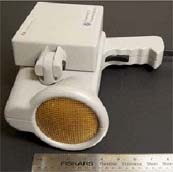
| Home | Information Sharing & Analysis | Prevention & Protection | Preparedness & Response | Research | Commerce & Trade | Travel Security | Immigration |

The threat level in the airline sector is High or Orange. Read more.


Truly from science to security, the lobster eye x-ray imaging device; shown here in this illustration; can peer into many types of cargo containers.
(November 2007) Want a device to see through walls, wood, concrete, earth, and steel? Scientists working for the DHS Science and Technology (S&T) Directorate looked around and found that nature sometimes comes in mighty handy.
Take the lobster.
Here you have a crustacean with an amazingly miniscule brain, yet this creature is able to “see” through walls of dense water obscured by silt and sand to find its food buried deep along the ocean bottom. Lobsters have limited image resolution, but possess high sensitivity and the ability to detect fast movement and the polarization of light. Over eons, this bottom crawler developed compound eyes to view its world through a large number of long, narrow square-shaped cells, arranged in a spherical array with a
This is some eye-opening stuff.
The eye that the
“LEXID is still very developmental, but it has some tremendous potential,” says Jim Apple of Physical Optics Corporation of Torrance, CA, which built the technology under a Small Business Innovation Research (SBIR) grant.
The Directorate has some tough specifications for this device. It must be able to “see” behind ship bulkheads, through several inches of soil, through steel, through wood beams, and through concrete. And, it must do this from about
LEXID has sparked interest from the
“In the wake of the
“Who’d have known we’d get our inspiration from lobsters?” adds Kirwin.
Request more information about this story.
This page was last reviewed/modified on September 3, 2008.